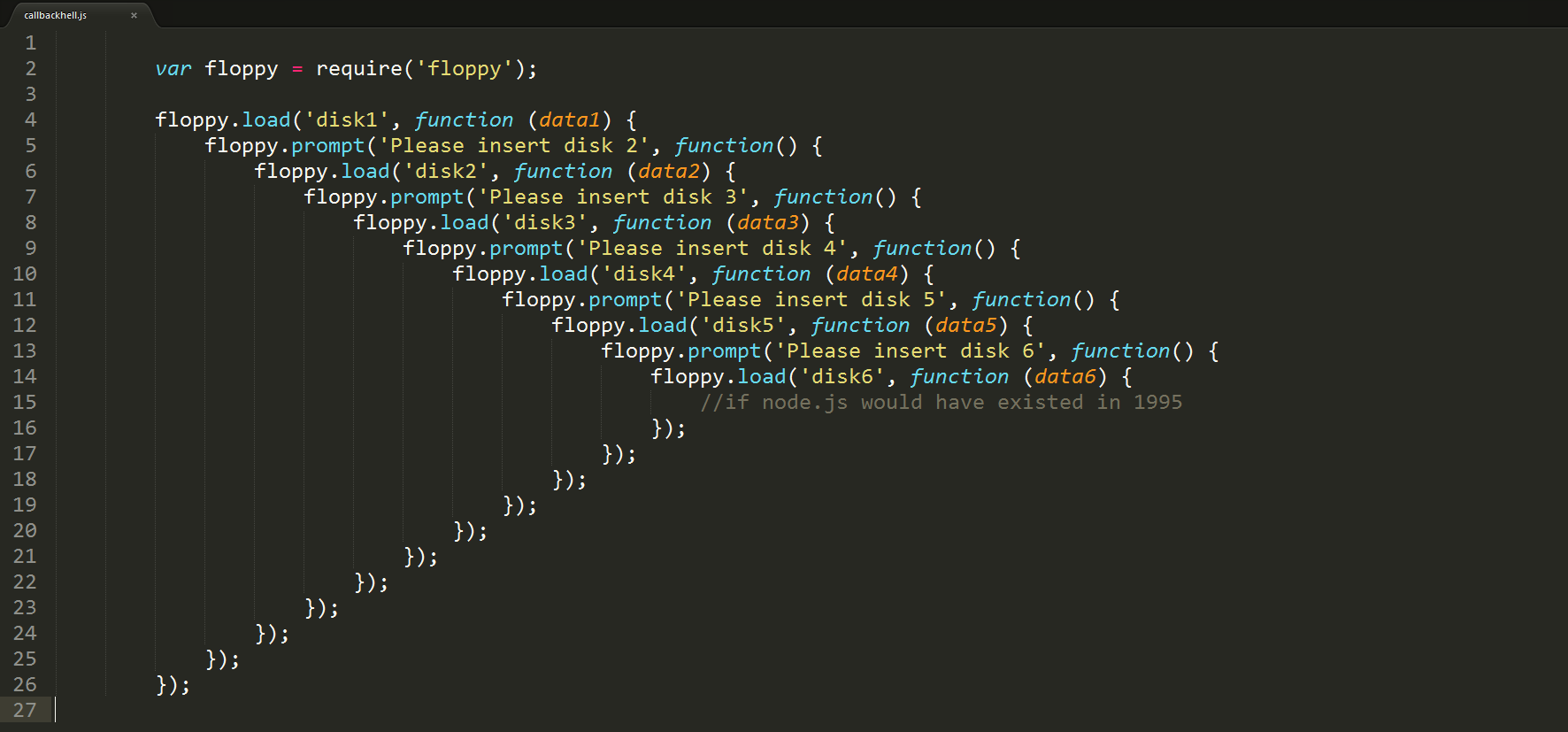JavaScript
Promises

Topics
- Brief Review of Asynchronous Code
- What are Promises?
- How do functions that use Promises actually work?
- Why Promises?
Asynchronous JavaScript
Some JavaScript Methods are Asynchronous
console.log('this prints first');
setTimeout(function() {
console.log('this prints last');
}, 0);
console.log('this prints second');JavaScript code runs synchronously, but we have a way of handling async code: asynchronous callbacks.
This code does not run "out of order". However, the callback to setTimeout is not executed right away, it runs after a timer expires on something called the "event loop".
jQuery AJAX
var planet;
$.getJSON('https://swapi.co/api/planets/1/', function(response) {
planet = response;
});
console.log(planet);Let's try to pull some data with jQuery's AJAX request, which utilizes callbacks
What is the value of planet?
Why is it undefined?!
The console.log was synchronous; it ran before the asynchronous callback.
jQuery AJAX
var planet;
$.getJSON('https://swapi.co/api/planets/1/', function(response) {
planet = response;
console.log('done', planet);
});
console.log('waiting');Let's fix it!
Asynchronous callbacks run after the rest of the code
Once you are inside the callback, the code executes predictably as per usual, (unless there are more async callbacks in there)
Takeaways
- JavaScript code is executed synchronously (in-order).
- JavaScript can use special asynchronous callbacks to delay the execution of certain pieces of code.
- Not all callbacks are asynchronous; you'll have to consult their documentation to tell.
Check out MDN's discussion of callbacks.
What
are
Promises?

Promise
A Promise is a new global object (as of ES6) that serves as a placeholder for asynchronous operations.
fetch('https://httpbin.org/get');
// -> Promise {<pending>}fetch is a modern web API built-in to the browser that uses promises.
Promise Syntax
Promises provide a .then and a .catch, which both accept callbacks.
fetch('https://httpbin.org/get')
.then(function(response) {
// the Promise resolved successfully
console.log(response);
})
.catch(function(error) {
// the Promise was rejected
console.log(error);
});Promise Chaining
You can chain .then statements together by having more promises, but you only ever need 1 .catch method at the end.
fetch('https://pokeapi.co/api/v2/pokemon/1/')
.then(function(response) {
return response.json();
})
.then(function(pokemon1) {
console.log(`The first pokemon is ${pokemon1.name}`);
return fetch('https://pokeapi.co/api/v2/pokemon/2/');
})
.then(function(response) {
return response.json();
})
.then(function(pokemon2) {
console.log(`The second pokemon is ${pokemon2.name}`);
})
.catch(function(error) {
// something bad happened
console.log(error);
});Use Arrow Functions
with Promises
fetch('https://pokeapi.co/api/v2/pokemon/1/')
.then(response => response.json())
.then(pokemon1 => {
console.log(`The first pokemon is ${pokemon1.name}`);
return fetch('https://pokeapi.co/api/v2/pokemon/2/');
})
.then(response => response.json())
.then(pokemon2 => console.log(`The second pokemon is ${pokemon2.name}`))
.catch(error => console.log(error));Same exact functionality as the previous slide
jQuery Promises
jQuery .ajax and .get and .getJSON methods support a Promise-like* interface as well:
$.getJSON('https://pokeapi.co/api/v2/pokemon/')
.then(pokemon => {
console.log(`Holy crap there are ${pokemon.count} pokemon now.`);
})
.catch(err => {
console.log(err);
});They are promises implemented before there were standard JavaScript promises.
Takeaways
- Promise is a global object used for asynchronous functions
- A promise represents a pending value (a guarantee that there will either be a resolved or rejected value)
- Standard promises all have a .then() method, which takes a callback of the resolved value, and this can be chained.
- Standard promises all also have a .catch() method, which takes a callback of the rejected value, and this can only be listed once at the end of a .then chain.
- The built-in fetch API and jQuery's ajax method both use promises.
How do
functions
that use
Promises
actually work?
Roll Our Own
Asynchronous Function
Let's make our own promise to see how they work:
function waitForSomeTime(ms) {
return new Promise(function(resolve, reject) {
try {
setTimeout(function() {
return resolve('Time is up!');
}, ms);
} catch (error) {
return reject(error);
}
});
}
waitForSomeTime(1000).then(res => console.log(res))Asynchronous
Function Recipe
function myAsyncFunction() {
// return a new Promise
return new Promise((resolve, reject) => {
/*
DO ASYNC STUFF HERE
*/
// if it succeeds, call the resolve callback
resolve(/* success value*/);
// if it fails, call the reject callback
reject(/* fail value*/)
})
}Why do
we have
Promises?
Callback Hell


Pokemon Callback Hell
$.getJSON('https://pokeapi.co/api/v2/pokemon/1/', pokemon1 => {
console.log(`The first pokemon is ${pokemon1.name}`);
return $
.getJSON('https://pokeapi.co/api/v2/pokemon/2/', pokemon2 => {
console.log(`The second pokemon is ${pokemon2.name}`);
return $
.getJSON('https://pokeapi.co/api/v2/pokemon/3/', pokemon3 => {
console.log(`The third pokemon is ${pokemon3.name}`);
return $
.getJSON('https://pokeapi.co/api/v2/pokemon/4/', pokemon4 => {
console.log(`The fourth pokemon is ${pokemon4.name}`);
})
.fail(error => console.log(error));
})
.fail(error => console.log(error));
})
.fail(error => console.log(error));
}).fail(error => console.log(error));
Pokemon with Promises
$.getJSON('https://pokeapi.co/api/v2/pokemon/1/')
.then(pokemon1 => {
console.log(`The first pokemon is ${pokemon1.name}`);
return $.getJSON('https://pokeapi.co/api/v2/pokemon/2/');
})
.then(pokemon2 => {
console.log(`The second pokemon is ${pokemon2.name}`);
return $.getJSON('https://pokeapi.co/api/v2/pokemon/3/');
})
.then(pokemon3 => {
console.log(`The third pokemon is ${pokemon3.name}`);
return $.getJSON('https://pokeapi.co/api/v2/pokemon/4/');
})
.then(pokemon4 => {
console.log(`The fourth pokemon is ${pokemon4.name}`);
})
.catch(error => console.log(error));Promise.all
let fourPokemonPromises = [];
for (let i = 1; i < 5; i++) {
fourPokemonPromises.push(
$.getJSON(`https://pokeapi.co/api/v2/pokemon/${i}/`)
);
}
Promise.all(fourPokemonPromises)
.then(pokemon => pokemon.forEach(p => console.log(p.name)))
.catch(err => console.log(err));Promise.all accepts an array of promises and will resolve when all of them pass or reject when any of them fail
This effectively lets you make several AJAX calls simultaneously, which can greatly improve the speed of your app.
Promise.race
var fourPokemonRace = [];
for (let i = 1; i < 5; i++) {
fourPokemonRace.push($.getJSON(`https://pokeapi.co/api/v2/pokemon/${i}/`));
}
Promise.race(fourPokemonRace)
.then(pokemon => console.log(pokemon.name))
.catch(err => console.log(err));
Promise.race accepts an array of promises and resolves or rejects the first one to finish.

When might this be useful?
Advanced
Promise Stuff
$.getJSON('https://swapi.co/api/planets/1/')
.then(res => {
let planet = res;
let filmsPlanetWasIn = planet.films;
return Promise.all(filmsPlanetWasIn.map(film => $.getJSON(film)));
})
.then(films => console.log(`Tattoine was in the following films: ${films}`))
.catch(err => console.log('Uh oh', err));Here is a combination of what we've learned; making a request to get data used to make a handful of requests efficiently.
Takeaways
- Promises can reduce the clutter of "callback hell" by utilizing promise-chaining, which has a clearer syntax
- Promises have advanced features like Promise.all and Promise.race that are much harder to implement using callbacks
- Many popular asynchronous JavaScript APIs are set up to use Promises, including jQuery's .ajax method, fetch, axios, and more